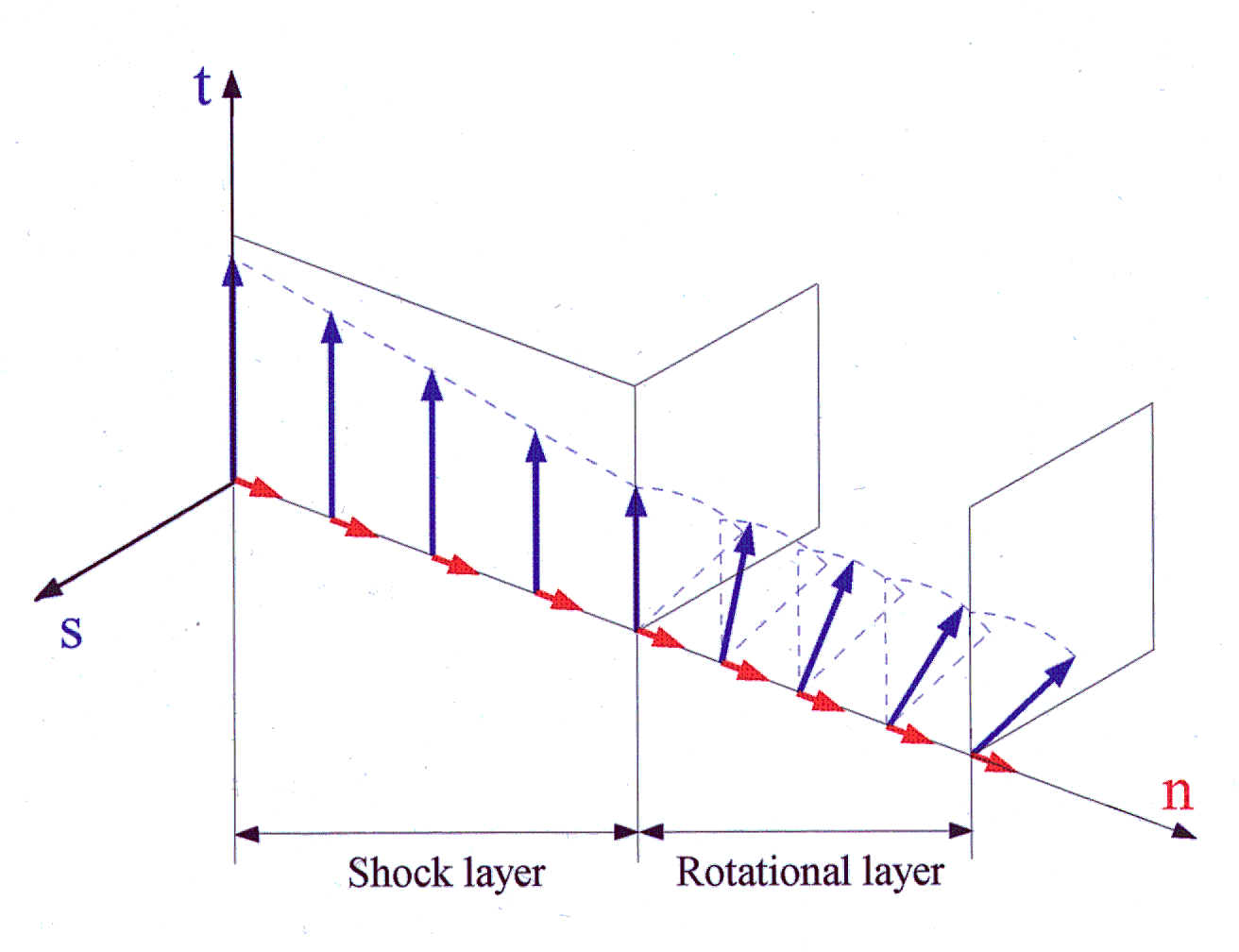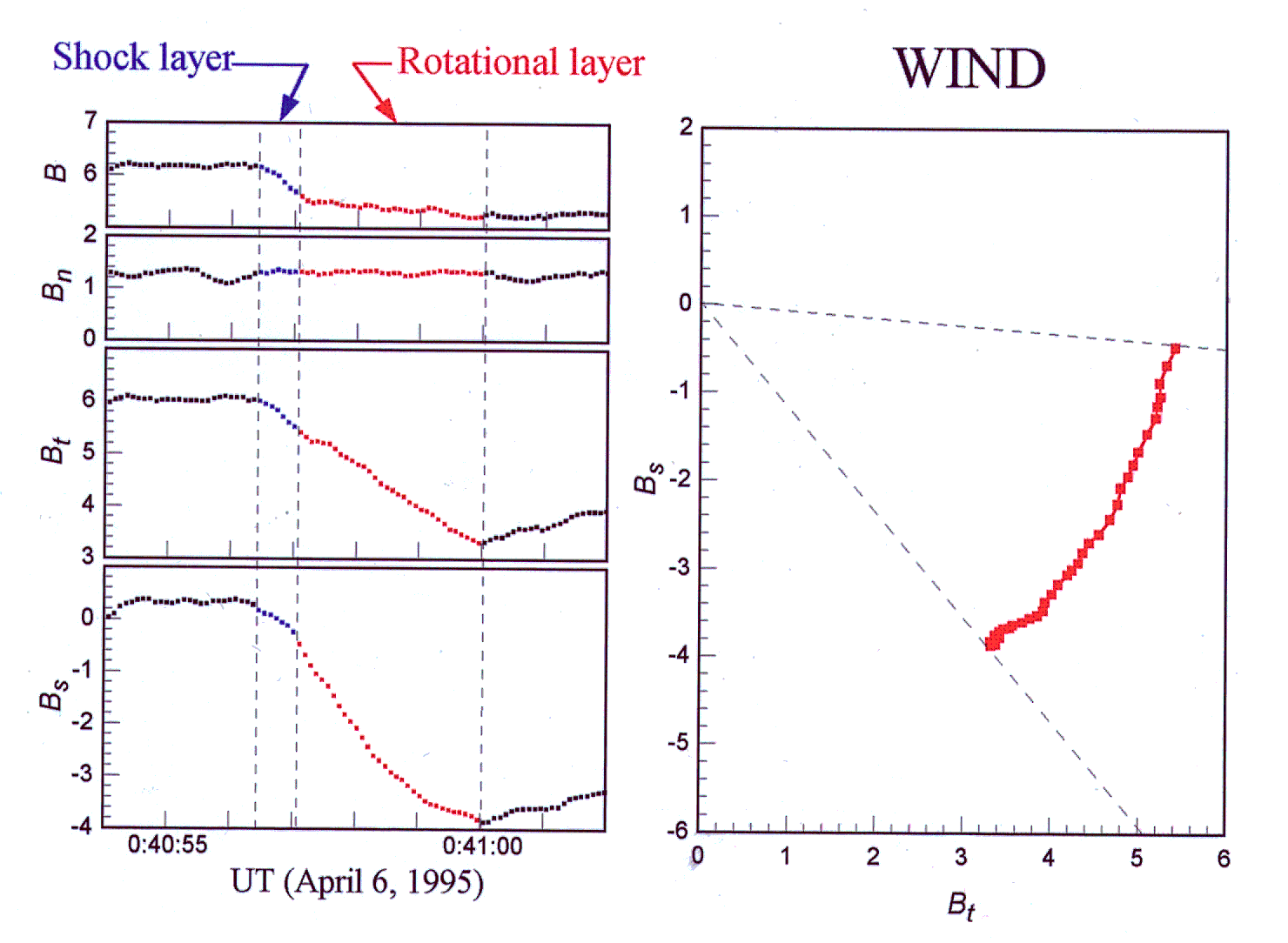
Double discontinuities were first discovered in interplanetary space from WIND MFI data. A double discontinuity is a compound structure composed of a slow shock layer and an adjoining rotational discontinuity layer on the postshock side as shown in Figure 1. The two successive discontinuity layers are very close to each other; the compound structure looks like a new kind of MHD discontinuity. Double discontinuities have been identified in interplanetary space from WIND, GEOTAIL and IMP-8 data [Whang et al., 1997a] and in the magnetotail from GEOTAIL and ISEE-3 data [Whang et al., 1997b].

Fig. 1. A double discontinuity is a compound structure composed of a slow shock layer and an adjoining rotational discontinuity layer. The component of the magnetic field normal to the surface of discontinuity, Bn (in red), remains nearly constant across the compound structure. The mag nitude of the magnetic field decreases across the shock layer. The components of the magnetic field parallel to the discontinuity surface, deconvolved into Bt and Bs (in blue)], rotates through a large angle across the rotational layer. "Courtesy of Y.C. Whang."
In Figure 2 are shown 8 seconds of high-resolution magnetic field data across a double discontinuity obtained from WIND on April 6, 1995. Bn is the component of the magnetic field normal to the surface of discontinuity, Bt and Bs are the two components of the magnetic field parallel to the surface of the discontinuity. A change in the magnitude of the magnetic field occurs across the double discontinuity and is mainly inside the shock layer. Across the rotational layer the magnetic field makes a significant rotation about the normal direction while its magnitude remains almost constant. Plasma properties across the discontinuity satisfy the jump conditions of an MHD slow shock. The variations of Bt and Bs across the rotational layer plotted on the right panel show that the magnetic field rotates by an angle of ~50°.

Fig. 2. The high-resolution magnetic field data show that the change i n the magnitude of the magnetic field occurs mainly inside the shock layer, and across the rotational layer the magnetic field rotates by an angle of ~50° about the normal direction. "Courtesy of Y.C. Whang."
The flows in the preshock region of all observed double discontinuities have small betai (ion plasma beta=8piNKTi / B2) values and large shock angles THETA. Two double discontinuities in interplanetary space were observed from dual spacecraft data; each had traveled over a distance of > 106 km between two observational positions, and the two crossing points on the surface of each double discontinuity were > 0.4 x 106 km apart. This means that double discontinuities are reasonably stable, large-scale solar wind structures.
The observed double discontinuities in interplanetary space are interpreted as resulting from the interaction of a rotational discontinuity approaching a slow shock from the postshock side. Apparently the rotational discontinuity does not penetrate through the shock layer, but it appears to merge into a new stable structure.
The observed double discontinuities in the magnetotail are related to the magnetic reconnection process at the boundaries between the plasma sheet and lobe [Petscheck, 1964; Vasyliunas, 1975]. A double discontinuity is capable of converting magnetic field energy into plasma thermal energy through its slow shock layer, and this allows a rapid rotation of the postshock magnetic field through its rotational layer to accommodate the magnetic field's environment in the plasma sheet. These properties imply that double discontinuities may play an important role for the reconnection process in space plasma.
Petschek, H. E., Magnetic field annihilation, in AAS-NASA Symposium on the Physics of Solar Flares, Edited by W. N. Hess, NASA Sp-50, pp. 425-439, 1964.
Vasyliunas, V. M., Theoretical models of magnetic field line merging, Rev. Geophys. Space Phys., 13, 303, 1975.
Whang, Y. C., J. Zhou, R. P. Lepping, A. Szabo, D. Fairfield, S. Kokubun, K. W. Ogilvie, and R. Fitzenreiter, Double Discontinuity: A Compound Structure of Slow Shock and Rotational Discontinuity, submitted to Journal of Geophysical Research, 1997a.
Whang, Y. C., D. Fairfield, E. J. Smith, R. P. Lepping, S. Kokubun, and Y. Saito, Observations of Double Discontinuities in the Magnetotail, Geophys. Res. Lett., in preparation, 1997b.
Y. C. Whang, Catholic University of America, Washington DC 20064
tel: 202-319-5977 fax: 202-319-4499 e-mail: whang@cua.edu